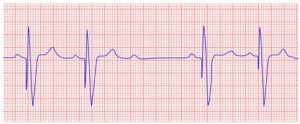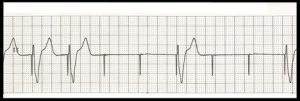What happens when a patient’s pacemaker seems to be malfunctioning? “Call the EP fellow” should not be your only answer! Take a look at the ECG, and ask yourself if the pacemaker may be over-sensing, under-sensing, or failing to capture.
Over-sensing:
The pacemaker is too sensitive. It interprets electric potentials that don’t come from the heart as myocardial contractions, causing it to fire too infrequently. This can be caused by electromagnetic interference (e.g. an MRI machine) or sensing myopotentials from outside the heart (e.g. from the rectus abdominal or pectoralis muscles).
Under-sensing:
The pacemaker is not sensitive enough. It fails to interpret real cardiac depolarizations as myocardial contractions, causing it to fire too frequently. This can be caused by metabolic disturbances, an MI, or conductor coil failure.
Failure to capture:
The pacemaker fires, but the myocardium does not contract. This can be caused by an elevated capture threshold (which can be due to a metabolic disturbance, an MI, or class IC anti-arrhythmics), or lead failure.
References:
- Martindale JL, Brown DFM. Rapid Interpretation of ECGs in Emergency Medicine: A Visual Guide. Philadelphia, PA (2012).
- http://lifeinthefastlane.com/ecg-library/pacemaker/
- http://lifeinthefastlane.com/ecg-library/pacemaker-malfunction/
- http://www.foamem.com/2014/01/16/lead-astray/



